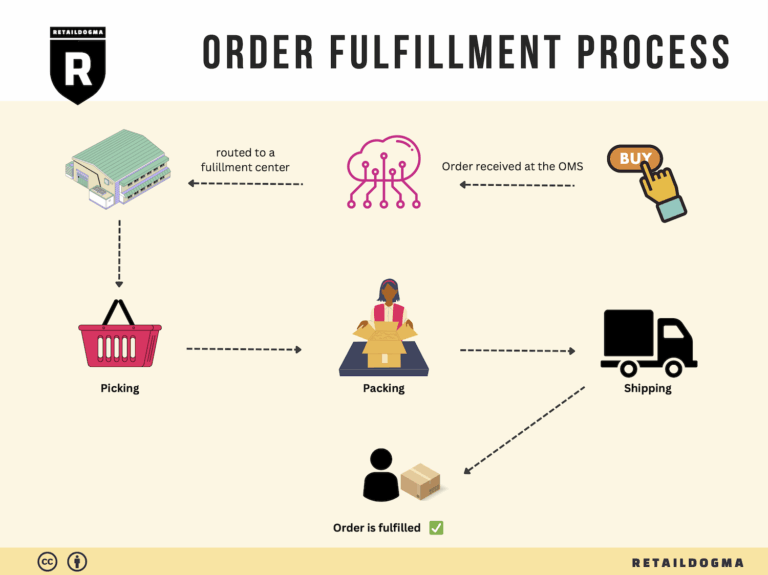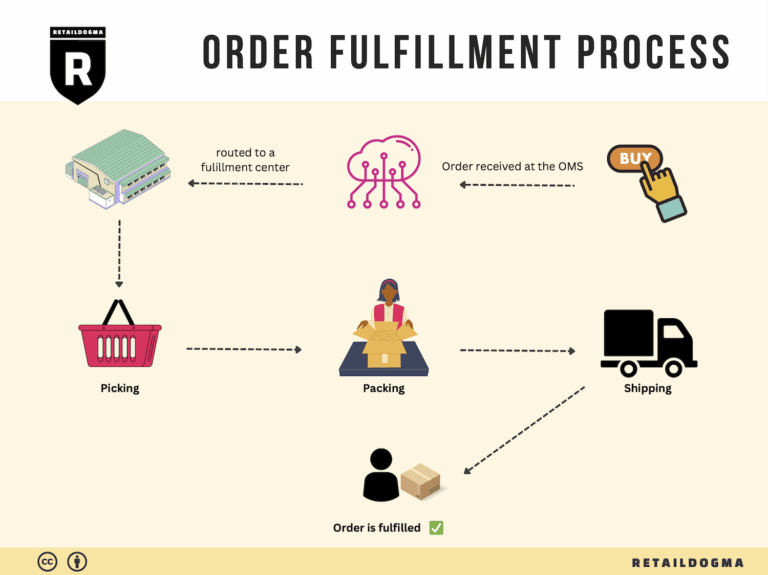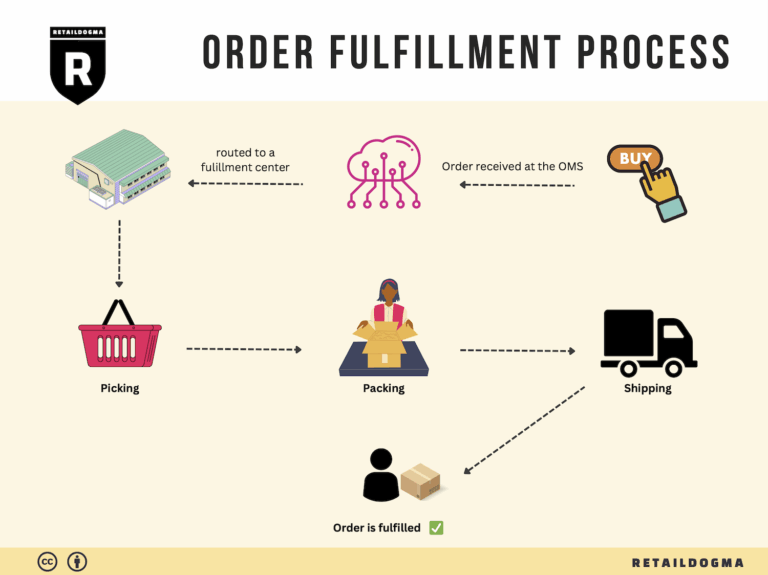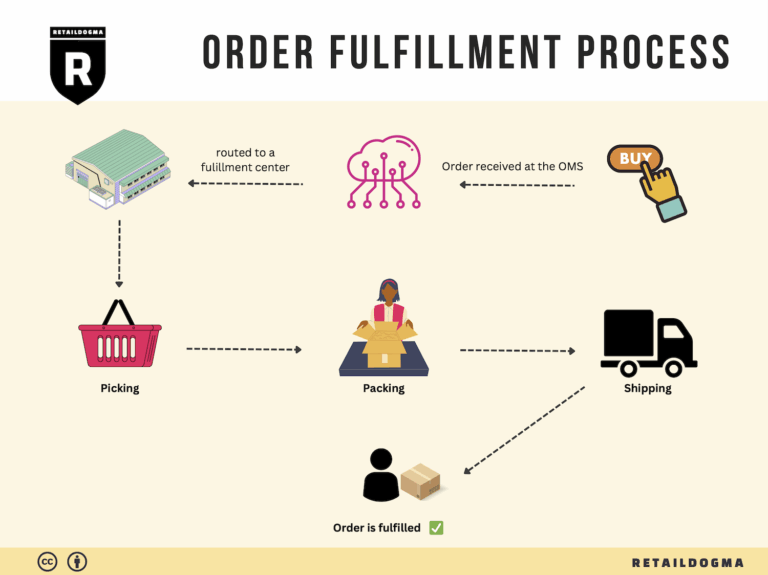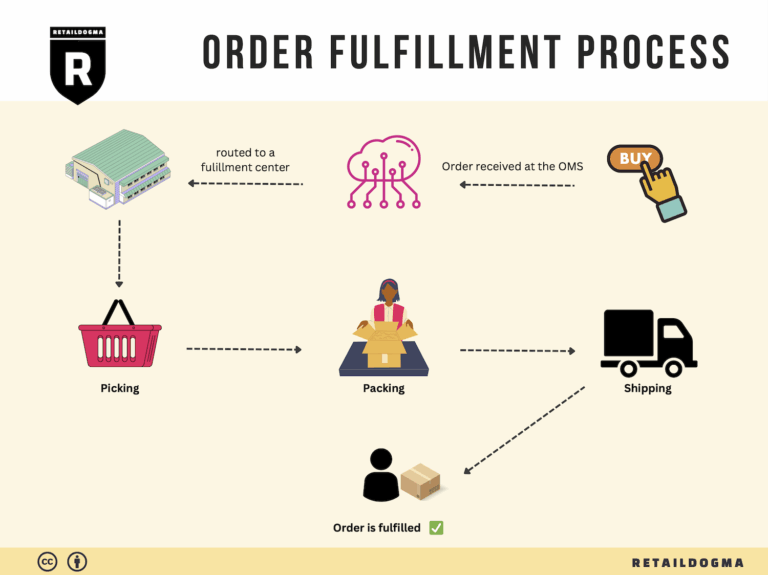How Order Fulfillment Works: A Step-by-Step Guide for Businesses
What is E-commerce Fulfillment? An Introduction for Growing Businesses
Understanding the Fulfillment Process
As your e-commerce business begins to grow, one of the most daunting challenges you may face is managing the packing and shipping of orders. The excitement of increasing sales can quickly turn into overwhelm as you juggle inventory management, order processing, and delivery logistics. This is where e-commerce fulfillment comes into play. Simply put, fulfillment is the process of getting a product from your warehouse or storage space to your customer’s doorstep.
The Fulfillment Landscape
In today’s competitive e-commerce environment, understanding the various fulfillment models is crucial for scaling your operations effectively. You may choose to handle fulfillment in-house, which involves managing your own inventory, packing orders, and shipping them out. Alternatively, you might consider partnering with a third-party logistics provider (3PL) or utilizing Fulfillment by Amazon (FBA). Each of these models comes with its own set of advantages and challenges, and the right choice for your business depends on your specific needs and growth objectives.
Core Fulfillment Services
At its core, fulfillment encompasses several key services: inventory storage, order processing, packing, shipping, and returns management. Understanding these services will help you identify what you need from a fulfillment partner. For instance, if you are selling perishable goods, you may require specialized storage and handling. If your products are high in volume, a partner with advanced technology and automation can enhance efficiency.
Choosing the Right Partner
Selecting the right fulfillment partner is a critical step in your e-commerce journey. Factors to consider include the partner’s geographical location, technology capabilities, service offerings, and customer support. A partner located near your customer base can significantly reduce shipping times and costs. Moreover, consider their experience with your specific product types, as this can impact handling and delivery efficiency.
Understanding Pricing Models
Pricing is another important aspect to consider when evaluating fulfillment options. Different models come with varying pricing structures, including flat fees, per-order fees, and storage fees. Understanding these costs will enable you to budget effectively and ensure that your logistics remain profitable as you scale.
Empowering Your Business
This guide aims to empower e-commerce businesses to make informed decisions about their logistics and fulfillment strategies. By providing insights into different fulfillment models, core services, partner selection criteria, and pricing, we hope to equip you with the knowledge needed to optimize your operations and focus on what you do best—growing your business.
What You’ll Learn In This Guide
- What is E-commerce Fulfillment? An Introduction for Growing Businesses
- The Order Fulfillment Process: From ‘Buy’ Button to Customer’s Door
- Comparing Fulfillment Models: In-House vs. 3PL vs. Dropshipping
- A Deep Dive into Amazon FBA: Pros, Cons, and Who It’s For
- Core Services Offered by Fulfillment Centers
- How to Choose a Fulfillment Partner: A 6-Point Checklist
- Understanding Fulfillment Pricing: A Breakdown of Common Fees
- Frequently Asked Questions (FAQs) about Fulfillment
- Conclusion: Is Outsourcing Fulfillment the Right Move for Your Business?
- Important Disclaimer
The Order Fulfillment Process: From ‘Buy’ Button to Customer’s Door
1. Receiving Inventory
The order fulfillment process begins with receiving inventory at the fulfillment center, such as the PHX3 Amazon Fulfillment Center located in Phoenix, Arizona. During this stage, products from suppliers are unloaded and checked against purchase orders to ensure accuracy. This process is critical for maintaining inventory accuracy and preventing stock discrepancies.
Once received, each product is assigned a Stock Keeping Unit (SKU), a unique identifier that helps in tracking inventory throughout the fulfillment process. This step is vital because any errors during receiving can lead to stockouts, overstock situations, or misallocated inventory, ultimately affecting customer satisfaction. Efficient receiving processes also set the tone for the entire fulfillment operation, ensuring that products are ready for storage and subsequent order processing.
2. Warehouse Storage
After receiving, the next step is warehouse storage. Products are organized in the fulfillment center based on various factors, including size, weight, and sales velocity. This organization facilitates quick access during the order picking phase. Advanced storage systems and warehouse management software (WMS) play a crucial role in optimizing space and improving efficiency.
The importance of effective warehouse storage cannot be overstated. Properly organized inventory reduces the time it takes to locate and retrieve items, thereby speeding up the fulfillment process. Additionally, a well-structured storage system minimizes the risk of damage and ensures that products are stored in optimal conditions. This phase often utilizes concepts like First In, First Out (FIFO) to manage perishable goods or high-demand items efficiently.
3. Order Picking
The third step is order picking, where items are selected from storage based on customer orders. This process typically involves using pick lists, which are generated by the WMS and detail the specific items and quantities required for each order. Employees or automated systems then navigate the warehouse to retrieve these items.
Order picking is crucial because it directly impacts the accuracy and speed of order fulfillment. Errors during this phase can lead to incorrect shipments, resulting in returns and diminished customer trust. To enhance efficiency, many fulfillment centers employ strategies such as batch picking (where multiple orders are picked simultaneously) and zone picking (where pickers are assigned specific areas of the warehouse). These techniques help streamline the picking process and reduce time spent on each order.
4. Order Packing
Once items are picked, they move to the order packing stage. Here, products are securely packaged for shipment. This includes placing items in appropriate boxes, adding packing materials to prevent damage during transit, and applying shipping labels with tracking information. The packing process often utilizes packing slips, which provide a summary of the order and ensure that all items are included.
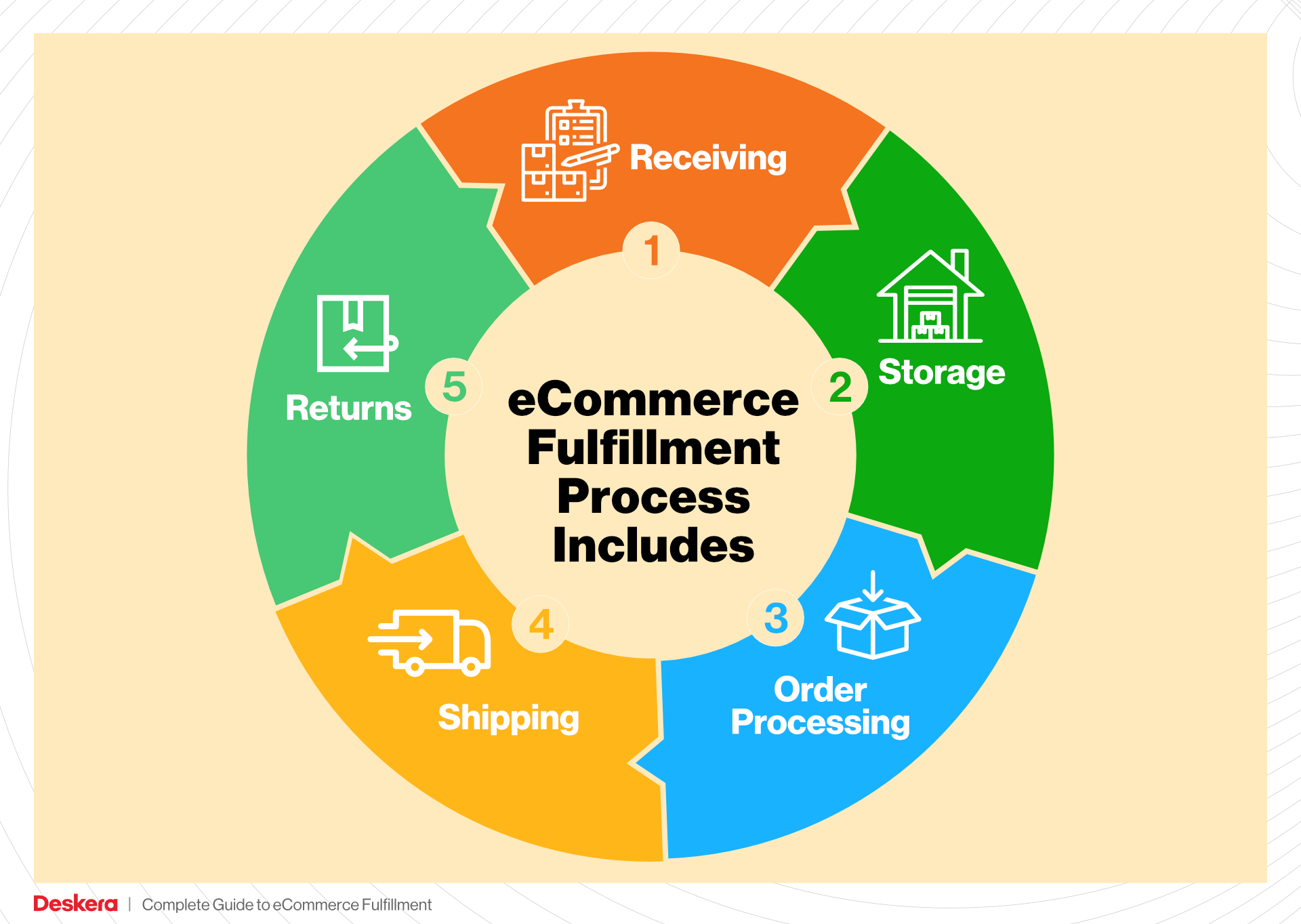
The significance of efficient order packing lies in its role in protecting products and ensuring timely deliveries. Well-packed orders are less likely to incur damage during shipping, which can save businesses money on returns and replacements. Moreover, a streamlined packing process can enhance the overall customer experience, as timely and accurate shipments build trust and loyalty. Many fulfillment centers are now adopting automated packing solutions to further increase efficiency and accuracy.
5. Shipping & Delivery
The final step in the order fulfillment process is shipping and delivery. Once packed, orders are handed off to shipping carriers for distribution to customers. At this stage, it’s essential to choose the right shipping methods based on factors like delivery speed, cost, and destination. Fulfillment centers like PHX3 often collaborate with multiple carriers to provide flexible shipping options.
Shipping and delivery are critical components of the fulfillment process because they directly affect customer satisfaction. Timely and reliable delivery can significantly enhance the customer experience, leading to repeat business and positive reviews. Tracking systems are also vital during this phase, as they allow both businesses and customers to monitor the shipment’s progress in real-time. Effective communication regarding shipping timelines and potential delays is essential to maintaining customer trust and managing expectations.
In summary, the order fulfillment process from receiving inventory to shipping and delivery is complex yet vital for e-commerce businesses. Each step must be executed efficiently to ensure customer satisfaction and operational success. By understanding and optimizing these processes, businesses can scale their operations effectively and meet the demands of a growing customer base.
Comparing Fulfillment Models: In-House vs. 3PL vs. Dropshipping
Fulfillment Model Comparison Table
| Model | Who Handles Inventory | Best For (Business Stage) | Key Advantage | Key Disadvantage |
|---|---|---|---|---|
| In-House Fulfillment | The business itself | Established businesses with stable sales | Full control over inventory and operations | High overhead costs and resource-intensive |
| Third-Party Logistics (3PL) | A third-party provider | Growing businesses looking to scale | Access to expertise and scalable solutions | Less control over inventory and potential delays |
| Dropshipping | Suppliers/manufacturers | Startups and small businesses | Low startup costs and minimal inventory risk | Lower margins and reliance on supplier reliability |
In-House Fulfillment
In-house fulfillment refers to managing the entire logistics process internally, where the business takes responsibility for storing, picking, packing, and shipping its products. This model is typically favored by established businesses with stable sales and adequate resources to handle logistics. One of the key advantages of in-house fulfillment is the complete control it offers over inventory management and order processing. Companies can implement customized workflows, ensuring quality control and the ability to respond swiftly to customer inquiries and needs. However, this model also comes with significant drawbacks, including high overhead costs associated with maintaining a warehouse, hiring staff, and investing in technology. Additionally, the complexity of managing logistics can divert attention from core business activities, making it challenging for companies to scale efficiently.
Third-Party Logistics (3PL)
Third-party logistics (3PL) involves outsourcing logistics operations to a specialized provider. This model is ideal for growing businesses that are looking to scale their operations without the burden of managing logistics themselves. A significant advantage of 3PL is access to expertise in supply chain management, which can lead to improved efficiencies and reduced shipping costs. Providers often have established networks and systems that can enhance delivery speed and reliability. However, businesses may experience less control over their inventory and operations, leading to potential delays or inaccuracies that could impact customer satisfaction. Furthermore, reliance on a third party can introduce complexities in communication and coordination, especially if the 3PL provider does not align well with the business’s goals and standards.
Dropshipping
Dropshipping is a fulfillment model where the retailer does not keep products in stock but instead transfers customer orders to a supplier who ships the products directly to the customer. This model is particularly advantageous for startups and small businesses due to its low startup costs and minimal inventory risk. Entrepreneurs can focus on marketing and sales without the burden of managing inventory or logistics. However, dropshipping has its disadvantages, such as lower profit margins compared to traditional retail models, as suppliers often take a significant cut of the sale price. Additionally, businesses relying on dropshipping are heavily dependent on their suppliers for product quality and timely shipping. Any issues with the supplier can directly affect customer satisfaction, making it essential for dropshippers to establish reliable partnerships and maintain clear communication.
Conclusion
Choosing the right fulfillment model is crucial for any e-commerce business looking to scale effectively. In-house fulfillment offers control but can be resource-intensive, while 3PL provides scalability and expertise at the cost of some control. Dropshipping allows for low-risk entry into the market but may lead to challenges in maintaining quality and margins. Businesses should assess their current stage, resources, and long-term goals when selecting a fulfillment strategy, ensuring it aligns with their operational capabilities and customer expectations.
A Deep Dive into Amazon FBA: Pros, Cons, and Who It’s For
Understanding Fulfillment by Amazon (FBA)
Fulfillment by Amazon (FBA) is a service that allows e-commerce sellers to store their products in Amazon’s fulfillment centers. Amazon takes care of storage, packaging, and shipping of the products directly to the customers. This service not only simplifies the logistics for sellers but also enhances their ability to reach a larger customer base, thanks to Amazon’s extensive network and reputation.
How FBA Works
-
Product Listing: Sellers create product listings on Amazon and choose to enroll in the FBA program. They can either send their products to one specific fulfillment center or distribute them across several centers based on Amazon’s recommendations.
-
Inventory Management: Once the products are received at Amazon’s warehouse, they are stored until an order is placed. Sellers can monitor their inventory levels through the Amazon Seller Central platform.
-
Order Fulfillment: When a customer places an order, Amazon handles all aspects of fulfillment. This includes picking the product from the warehouse, packing it securely, and shipping it directly to the customer.
-
Customer Service: Amazon also manages customer service and returns for FBA orders, allowing sellers to focus on other aspects of their business.
-
Payment: Sellers receive payments for their sales after deducting FBA fees, which cover storage and fulfillment services.
Pros of Using Amazon FBA
Prime Eligibility
One of the most significant advantages of FBA is that products become eligible for Amazon Prime, which attracts millions of loyal Prime members who prefer fast, free shipping. This can significantly increase sales for sellers.
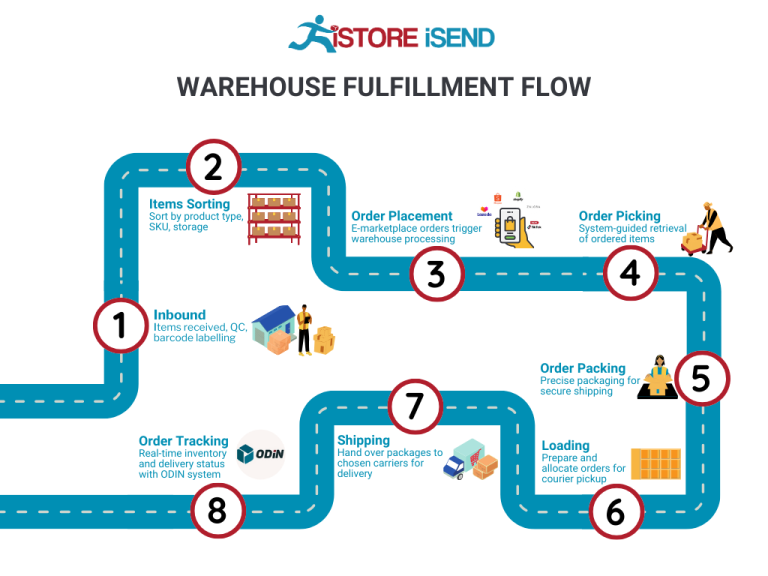
Customer Trust
Products fulfilled by Amazon benefit from the trust and reliability associated with the Amazon brand. Customers are more likely to purchase items that are backed by Amazon’s customer service and return policies.
Multi-Channel Fulfillment
FBA allows sellers to fulfill orders not just from Amazon but also from their own websites or other platforms. This multi-channel fulfillment capability helps streamline operations and maintain consistent customer experiences across different sales channels.
Scalability
FBA allows businesses to scale without needing to invest heavily in warehousing and logistics. As demand grows, sellers can send more inventory to Amazon’s centers, and the fulfillment process remains efficient.
Simplified Logistics
With Amazon handling storage, packing, and shipping, sellers can focus on marketing and product development. This simplifies the logistics involved in running an e-commerce business.
Cons of Using Amazon FBA
High Fees
While FBA provides numerous benefits, it comes with high fees, including storage fees (charged monthly based on the space your inventory occupies) and fulfillment fees (charged per unit sold). These costs can add up quickly, especially for sellers with lower-margin products.
Strict Inventory Rules
Amazon imposes strict inventory management rules, including limits on the amount of inventory sellers can send to their fulfillment centers. This can lead to challenges for sellers who experience sudden spikes in demand.

Commingling Risks
FBA products are often commingled, meaning that inventory from different sellers may be mixed together. This can lead to issues if a seller’s products are returned or damaged, as it may be difficult to track and reclaim specific items.
Reduced Control Over Customer Experience
By using FBA, sellers relinquish some control over the fulfillment process. This can lead to inconsistencies in packaging and shipping that may affect the customer experience.
Dependency on Amazon
Relying heavily on Amazon for fulfillment can be risky. Changes in Amazon’s policies, fees, or algorithms can directly impact a seller’s business, making it essential for sellers to diversify their sales channels.
Who is FBA Best For?
Fulfillment by Amazon is particularly well-suited for:
-
Small to Medium-Sized Businesses: FBA allows smaller businesses to leverage Amazon’s vast logistics network without the need for significant capital investment in warehousing and shipping.
-
Entrepreneurs with Limited Time: Sellers who want to minimize the time spent on logistics and customer service can benefit from FBA’s hands-off approach.
-
Brands Looking to Scale: For brands aiming to grow rapidly, FBA provides the infrastructure needed to manage increased order volumes without the typical growing pains associated with logistics.
-
Retailers with Seasonal Products: Businesses that experience fluctuating demand can use FBA to manage inventory more effectively, avoiding the overhead costs of maintaining a warehouse.
-
Sellers Targeting Prime Customers: Businesses that want to tap into Amazon’s Prime customer base should consider FBA, as it enhances visibility and attractiveness to these shoppers.
In conclusion, Fulfillment by Amazon offers a powerful solution for e-commerce sellers looking to streamline their operations and reach a broader audience. However, it’s essential to weigh the pros and cons carefully to determine if FBA aligns with your business strategy and growth ambitions.
Core Services Offered by Fulfillment Centers
Inventory Management & Warehousing
Inventory management and warehousing are foundational services provided by fulfillment centers. This involves the systematic handling of goods as they are received, stored, and prepared for shipment. Fulfillment centers like the PHX3 Amazon Fulfillment Center utilize advanced inventory management systems that track stock levels, monitor product movement, and forecast demand.
The benefits of effective inventory management include:
- Reduced Holding Costs: By optimizing storage space and ensuring that inventory levels are aligned with demand, businesses can minimize costs associated with overstocking and storage fees.
- Enhanced Accuracy: Automated inventory tracking reduces human error, ensuring that businesses have accurate data on product availability. This is crucial for maintaining customer satisfaction, as it prevents stockouts or overselling.
- Scalability: As an e-commerce business grows, having a fulfillment partner that can manage larger volumes of inventory efficiently allows for smoother scaling without the need for significant investment in additional warehousing infrastructure.
Pick and Pack Services
Pick and pack services are essential for e-commerce operations, involving the process of selecting (or “picking”) products from inventory and preparing them for shipment (or “packing”). Fulfillment centers streamline this process through efficient systems and trained personnel.
The advantages of pick and pack services include:
- Speed and Efficiency: Fulfillment centers employ sophisticated software and systems to quickly locate items and prepare orders, reducing the time it takes to fulfill customer requests. This is especially beneficial during peak seasons when order volumes surge.
- Customization: Many fulfillment centers offer customized packing solutions, allowing businesses to include branded materials, gift wrapping, or personalized messages. This enhances the customer experience and can lead to increased brand loyalty.
- Error Reduction: With systematic processes and checks in place, fulfillment centers minimize mistakes in order fulfillment, leading to higher customer satisfaction rates and fewer returns.
Kitting and Assembly
Kitting and assembly services involve combining multiple products into a single package or assembling products before shipping. This can include bundling items for promotional offers or assembling components into a final product.
The benefits of kitting and assembly services include:
- Streamlined Operations: By outsourcing kitting and assembly to a fulfillment center, e-commerce businesses can focus on core activities such as marketing and sales, leaving the logistical complexities to specialists.
- Increased Sales Opportunities: Bundling products together can encourage customers to purchase more items at once, thus increasing average order value. For instance, a fulfillment center can package related items together, making it easier for customers to buy a complete solution.
- Time Savings: Kitting and assembly often require specialized skills and equipment. By using a fulfillment center’s resources, businesses can save time and reduce the need for in-house labor.
Returns Management (Reverse Logistics)
Returns management, or reverse logistics, is the process of handling returned products from customers. Fulfillment centers play a crucial role in managing returns efficiently, ensuring that businesses can maintain positive customer relationships even when issues arise.
The benefits of effective returns management include:
- Customer Retention: A streamlined returns process can enhance customer satisfaction, making it more likely that customers will return for future purchases. Fulfillment centers often provide pre-paid return labels and clear instructions to simplify the process for customers.
- Inventory Reassessment: Efficient handling of returns allows businesses to quickly assess returned items for restocking or refurbishment, minimizing losses and maximizing inventory utilization. This agility can be a significant competitive advantage.
- Data Insights: Analyzing return data can provide valuable insights into customer behavior and product quality. By understanding why products are returned, businesses can make informed decisions about product offerings, marketing strategies, and quality control measures.
In summary, leveraging the core services offered by fulfillment centers such as inventory management, pick and pack services, kitting and assembly, and returns management is critical for e-commerce businesses aiming to scale efficiently. These services not only optimize logistics operations but also enhance customer satisfaction, ultimately contributing to sustainable growth.
How to Choose a Fulfillment Partner: A 6-Point Checklist
Location & Warehouse Network
Importance:
The geographical location of your fulfillment partner plays a crucial role in your overall logistics strategy. A strategically placed warehouse network can significantly reduce shipping times and costs, especially if you serve a wide geographic area.
Questions to Ask:
– Where are the fulfillment centers located, and how does that align with my customer base?
– What is the average shipping time to major regions from the fulfillment center?
– Do they have multiple facilities to facilitate quicker delivery across different regions?
– What transportation partnerships do they have in place to ensure timely deliveries?
Technology & Integrations
Importance:
In today’s fast-paced e-commerce landscape, technology is vital for operational efficiency. Your fulfillment partner should offer robust systems that integrate seamlessly with your existing e-commerce platforms, inventory management tools, and shipping carriers.
Questions to Ask:
– What technology platforms do you use for order management and tracking?
– Can your systems integrate with my e-commerce platform (e.g., Shopify, WooCommerce, Amazon)?
– Do you provide real-time inventory tracking and reporting?
– How do you handle data security and compliance with regulations?
Specializations (e.g., cold storage, oversized items)
Importance:
Different businesses have unique needs based on the types of products they sell. If your products require special handling—like temperature control for perishables or additional space for oversized items—ensure your fulfillment partner can accommodate these requirements.
Questions to Ask:
– Do you have specialized facilities for specific types of products (e.g., cold storage for food items)?
– How do you handle fragile or oversized items?
– What protocols are in place to ensure product safety during storage and shipping?
– Can you manage seasonal fluctuations in product types or inventory levels?
Scalability & Capacity
Importance:
As your business grows, your fulfillment partner should be able to scale with you. This means having the capacity to handle increased order volumes without compromising service quality.
Questions to Ask:
– What is your current capacity for order fulfillment, and how do you handle peak seasons?
– How quickly can you scale operations to meet my business growth?
– Are there limitations on the types or volumes of products you can handle?
– What steps do you take to manage unexpected surges in demand?
Pricing and Contracts
Importance:
Understanding the pricing structure and contract terms is essential to avoid hidden fees and ensure you can budget effectively. Transparent pricing allows you to make informed decisions that align with your financial goals.
Questions to Ask:
– What is your pricing model (e.g., per order, per item, monthly fees)?
– Are there any additional fees for services like storage, handling, or returns?
– What are the contract terms, and is there flexibility for renegotiation as my business changes?
– Do you offer incentives for long-term contracts or high-volume shipping?
Customer Support & Reviews
Importance:
Reliable customer support is critical for resolving issues quickly and maintaining smooth operations. Additionally, reviewing testimonials and feedback from other clients can provide insights into the partner’s reliability and service quality.
Questions to Ask:
– What customer support options do you offer (e.g., phone, email, chat)?
– What are your average response times for support inquiries?
– Can you provide references or case studies from similar businesses you’ve worked with?
– How do you handle issues such as lost packages or shipping delays?
Conclusion
Choosing the right fulfillment partner is a significant decision that can impact your business’s efficiency and customer satisfaction. By carefully evaluating potential partners using this checklist, you can ensure that your chosen fulfillment center meets your operational needs and supports your business’s growth objectives. A well-selected partner not only streamlines your logistics but can also enhance your brand’s reputation through reliable and timely delivery services.
Understanding Fulfillment Pricing: A Breakdown of Common Fees
Initial Setup Fees
Initial setup fees are typically one-time charges that e-commerce businesses incur when they first engage with a fulfillment center. These fees can cover a variety of services, such as account creation, system integration, and initial training on using the fulfillment platform.
The calculation of initial setup fees can vary widely between providers. Some fulfillment centers may charge a flat fee, while others might assess costs based on the complexity of the integration with your existing systems. It’s advisable to ask for a breakdown of these fees to understand what specific services are included.
Receiving Fees
Receiving fees are charged when inventory is delivered to the fulfillment center. This fee covers the labor and resources needed to unload, inspect, and process incoming products.
Typically, receiving fees are calculated per unit or per pallet. For instance, a fulfillment center may charge a set fee for each pallet received, or a per-item fee for smaller shipments. It’s essential to clarify what constitutes a ‘unit’ or ‘pallet’ with your chosen provider, as definitions can vary. Additionally, some centers may have minimum receiving fees, especially if the shipment is below a certain threshold.
Storage Fees (per pallet/bin)
Storage fees are ongoing charges that apply to the inventory stored at the fulfillment center. These fees are generally calculated on a monthly basis and can be assessed per pallet or per bin.
Most fulfillment centers will offer tiered pricing based on the volume of inventory you store. For example, the first few pallets may be charged at a higher rate, while larger volumes benefit from discounted rates. Additionally, you may encounter fees for long-term storage if your products remain unsold for an extended period, typically over six months. Understanding these structures can help you manage your inventory levels effectively.
Pick & Pack Fees (per item/order)
Pick and pack fees are charges for the labor involved in retrieving items from storage and packaging them for shipment. This fee usually consists of two components: the picking fee, which is charged for each item retrieved, and the packing fee, which covers the materials and labor needed to prepare the order for shipping.
These fees can be calculated per item or per order, depending on the fulfillment center’s pricing model. For example, a center might charge a flat fee for orders containing up to a certain number of items, and an additional fee for each item beyond that limit. It’s crucial to understand the specifics of how these fees are structured, as they can significantly affect your overall fulfillment costs.
Shipping Fees
Shipping fees are the charges associated with delivering packages from the fulfillment center to the customer. These fees can vary based on several factors, including the shipping method selected (standard, expedited, etc.), the destination, and the weight and dimensions of the package.
Many fulfillment centers offer discounted shipping rates through partnerships with major carriers, which can lead to significant savings for businesses. Shipping fees can be calculated based on weight, size, or a flat rate depending on the carrier and service level chosen. It’s advisable to discuss shipping options and potential discounts with your fulfillment provider to ensure you are getting the best rates available.
Tips for Getting an Accurate Quote
-
Request a Detailed Breakdown: When seeking quotes, ask for a comprehensive breakdown of all potential fees. This will help you understand the total cost structure and avoid unexpected charges later on.
-
Compare Multiple Providers: Don’t settle for the first quote you receive. Compare offers from different fulfillment centers to find the best value for your specific needs.
-
Consider Volume Discounts: If you anticipate high order volumes, inquire about volume-based pricing that may reduce your per-unit costs.
-
Assess Additional Services: Some fulfillment centers offer value-added services, such as kitting, labeling, or returns management. Factor these into your overall cost analysis.
-
Evaluate Contract Terms: Review the contract terms carefully, paying attention to any potential hidden fees or penalties for early termination, as these can impact your long-term costs.
By understanding these common fulfillment pricing models and following these tips, you can make informed decisions that align with your business’s operational goals and budget constraints.
Frequently Asked Questions (FAQs) about Fulfillment
1. What are the operating hours of the PHX3 Amazon Fulfillment Center?
The PHX3 Amazon Fulfillment Center operates 24 hours a day, seven days a week, providing flexibility for both incoming and outgoing shipments. It’s advisable to confirm hours during holidays or peak seasons.
2. Does PHX3 offer overnight parking for delivery drivers?
Yes, PHX3 provides overnight parking facilities for drivers. This amenity helps ensure that drivers have a safe and convenient place to rest while waiting for their next delivery.
3. Is assistance available for loading and unloading packages?
Absolutely. The staff at PHX3 is typically available to assist with the loading and unloading of packages, enhancing operational efficiency and minimizing delays.
4. What amenities are provided for delivery drivers?
PHX3 offers various amenities for delivery drivers, including rest areas and restroom facilities. These features help create a more comfortable environment during breaks.
5. Can customers expect timely deliveries from PHX3?
While PHX3 generally maintains a strong track record for timely deliveries, occasional delays may occur due to high volume or unforeseen logistical challenges. Staying informed about peak times can help manage expectations.
6. What is the difference between a warehouse and a fulfillment center?
A warehouse is primarily a storage facility where goods are kept until they are needed, while a fulfillment center is designed specifically for processing and shipping orders directly to customers. Fulfillment centers often include additional services such as inventory management, order picking, and packing.
7. What is a Third-Party Logistics provider (3PL)?
A Third-Party Logistics provider (3PL) is a company that offers logistics services to businesses, including warehousing, transportation, and fulfillment. Utilizing a 3PL can help businesses scale their operations without investing in their own logistics infrastructure.
8. How much do fulfillment services cost?
The cost of fulfillment services can vary widely based on factors such as storage space, order volume, and additional services required (like packaging and shipping). On average, businesses can expect to pay a combination of monthly storage fees and per-order fulfillment fees. It’s best to get a customized quote based on your specific needs.
9. What should I consider when choosing a fulfillment center?
When selecting a fulfillment center, consider factors such as location, shipping speed, technology integration, customer service quality, and the range of services offered. Additionally, evaluate the facility’s capacity to handle your order volume and scalability as your business grows.
10. How does PHX3 handle package delivery issues?
PHX3 has protocols in place for managing package delivery issues. However, some customers have reported occasional mishandling. It’s essential for businesses to maintain clear communication with the fulfillment center to address any concerns promptly and ensure a smooth delivery process.
Conclusion: Is Outsourcing Fulfillment the Right Move for Your Business?
Assessing the Benefits of Outsourcing Fulfillment
Outsourcing fulfillment can offer significant advantages for e-commerce businesses aiming to scale efficiently. One of the primary benefits is time savings. By partnering with a dedicated fulfillment center like PHX3, you can redirect your focus from logistics to core business activities such as marketing, product development, and customer engagement. This shift allows for more strategic decision-making and ultimately drives growth.
Scalability is another compelling reason to consider fulfillment services. As your business grows, your logistics needs can become increasingly complex. A fulfillment partner can easily adjust to your changing demands, whether it’s ramping up during peak seasons or managing fluctuations in order volume. This flexibility ensures that you can meet customer expectations without the overhead of maintaining your own warehousing and shipping infrastructure.
Moreover, leveraging the expertise of a fulfillment center brings operational efficiencies that are often unattainable in-house. Experienced providers like PHX3 have established processes, technology, and trained staff that enhance order accuracy and speed. Their ability to manage inventory effectively and reduce shipping costs can significantly improve your bottom line.
However, the importance of selecting the right fulfillment partner cannot be overstated. As you evaluate your options, consider factors like operational efficiency, location, and customer service quality. The right partner will align with your business goals and contribute to your overall strategy.
Take Action
To determine if outsourcing fulfillment is the right move for your business, conduct a thorough audit of your current shipping process. Assess whether your current setup is scalable and efficient enough to support your growth ambitions. If not, it may be time to explore partnerships with fulfillment centers like PHX3 that can help you streamline operations and enhance customer satisfaction. Embrace the opportunity to optimize your logistics strategy and take your business to the next level.
Important Disclaimer
⚠️ Important Disclaimer
The information in this guide is for educational purposes. Fulfillment services, pricing, and platform features change frequently. Always conduct your own due diligence and consult with providers directly before making business decisions.

